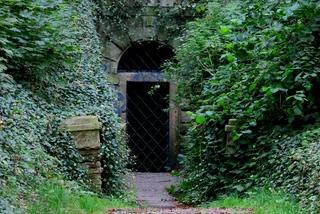"New" is a relative term in Prague. Emperor Charles IV established Prague’s New Town on March 8, 1348, some 675 years ago. It's only “new” when compared to Old Town, which has its roots in the ninth century.
The district, called Nové Město in Czech, was built as a walled city. It was separated from Old Town by a wall that ran along Na Příkopě Street, where there was a moat until 1760. Walls also surrounded the other sides of the settlement.
Charles IV had grand plans for his creation. He envisioned the city as a “New Jerusalem,” a holy city that would become a spiritual and pilgrimage center. The Crusades had gone badly for Christian forces, and the real Jerusalem was under Muslim rule at the time. New Town was intended as a substitute.

The plans for New Town were roughly based on maps of Jerusalem. What is now called Karlovo náměstí, originally the Cattle Market (Dobytčí trh), was placed to correspond to Solomon's Temple stood.
The plan called for Karlovo náměstí to become the town’s main square but Wenceslas Square, the former Horse Market (Koňský trh), retained the honor. The district's third market square, the Hay Market (Senný trh) was at what is now Senovážné náměstí.
In the Middle Ages, Karlovo náměstí was home to the Chapel of Corpus Christi (kaple Božího Těla). Originally, in the time of Charles IV, it was a wooden structure, but a stone chapel was built shortly after Charles IV’s death and stood until 1791. After it was torn down, the stones were recycled into buildings in the surrounding area.

PARTNER ARTICLE
The chapel was used for an annual display of the Crown Jewels as well as some of the holy relics that the emperor had collected – wood allegedly from the True Cross, a nail from the cross, part of the Crown of Thorns, the Spear of St. Longinus, and other religious items linked to the Jesus and many saints. The display took place on the "Feast of the Spear and the Nail" on the first Friday after Easter.
Pilgrims would come from far and wide to see the jewels and relics. Those who died along the pilgrimage route were eligible for burial in the chapel's churchyard. The chapel and churchyard were located near the tram track that now runs through the center of the square. Occasionally, renovation work on the tracks uncovers leftover bits of stonework.
A small movement has been trying to revive the tradition, though rebuilding the chapel is unlikely as it would mean altering the tram route.
X marks the spot
Like many people of his time, Charles IV was convinced the world would soon end, and God would return to earth the separate the righteous from the sinners. God would have to chose a place to come and do this, and Charles IV intended for that place to be New Town. Once God sorted out the good from the bad people, the chosen ones would stay and spend eternity happily in the planned city – a purpose built heaven on earth.

The emperor's vast collection of relics and the several new churches were meant to be an enticement. Five of the churches in the city plan, when connected, form a cross on the map with the Chapel of Corpus Christi in the middle, making the whole district a sort of sacred area – with an "X marks the spot" for heavenly powers to aim for when coming down to start the Apocalypse.
The world, though, persisted. The relic collection of Charles IV has been split up, with some items in Karlštejn, others in St. Vitus’ Cathedral, and the rest are spread in churches across the city. The stone coffin of St. Longinus is at the Basilica of Sts. Peter and Paul in Vyšehrad, while the spear – sometimes called the Spear of Destiny – is now in Vienna, though the National Museum has a copy that's occasionally exhibited.

Prague's first defenestration
Arguably, New Town’s biggest claim to fame was at the start of the Hussite Wars. The first defenestration took place at the New Town Hall (Novoměstská radnice).
A crowd of Hussites, the followers of religious reformer Jan Hus, threw seven city councilors out of a tower window on July 30, 1419. The councilors died as a result.

King Wenceslas IV, who had succeeded Charles IV, was so upset by the incident that his health declined and he died on Aug 16, 1419. Talks to resolve religious differences between the Hussites and Catholics broke down after the defenestration, and the Hussite Wars began – lasting until 1434.
New Town Hall still stands and is used for art exhibitions and special events, and has a cafe. The defenestration was re-enacted in 2019. Clever readers will spot that "first" defenestration implies there were others. There are three or four, depending on whether the death of politician Jan Masaryk in 1948 is counted.

All that remains of the wall separating Old Town from New Town is the Powder Tower, one of the entry gates to Old Town, and the Church of St. Martin in the Wall (kostel svatého Martina ve zdi) on Martinská Street, near Národní.
The Gothic walls that ran around the other sides were also town down over the centuries, with a small section remaining on Na Slupi Street. Remnants of later Baroque walls can still be found in the Folimanka and Vyšehrad areas.
In the long term, renovations are planned for Karlovo náměstí more user-friendly, but for now it still retains a bit of an unsavory character. The lower part of Wenceslas Square is also undergoing a transformation, and the upper part will soon follow with tram tracks being restored.
For a long time, Na Příkopě Street had the highest commercial rents in the city, but it has recently been overtaken by Pařížská Street. The district now is home to a large mix of business and residential properties, schools, and hospitals, as well as a lot of hotels and flats used for shared accommodation.












 Reading time: 5 minutes
Reading time: 5 minutes 


























